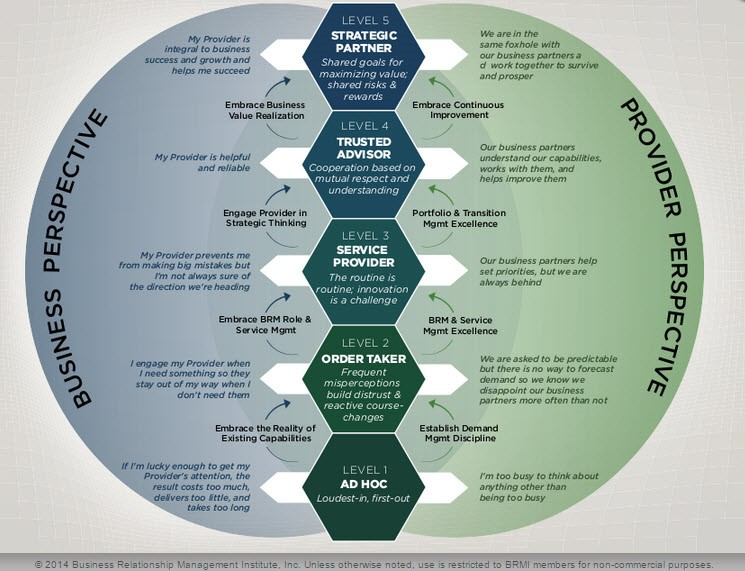Business Relationship Management (BRM)
By Elaine Lincoln, Ed.D., CBAP, PMI-PBA, BRMP
Feb 1, 2016
Last summer I had the opportunity to attend a BRM Foundation course. I was excited to learn about this role, which is not really a new role, but a role that has in the past two years become “professionalized”, meaning by that, it has its own:
- Professional organization devoted to Business Relationship Management practitioners: The Business Relationship Management Institute (BRMI)
- Interactive Body of Knowledge (BRMBOK™) that describes the role, techniques used by Business Relationship Managers (BRMs) and the competencies needed to be an effective BRM
During the course I was introduced to BRM terminology, tools, and techniques aimed at providing a common language for understanding the role.
Having been a practicing Business Analyst for many years of my career, I was struck by what I perceived as a very strong similarity between the BRM role and the work I performed as a BA:
- I could identify with the metaphors that were used to describe the BRM as a navigator, orchestrator and connector between the business and the provider organization.
- The BRM operated as an extreme advocate of the business, but without project boundaries.
- The basic concepts of “Business Demand”, “Provider Supply” and helping an organization to maximize business value from their investments resonated with me.
They even had a Business Relationship Maturity Model:
- To help organizations identify their current level of relationship maturity
- To raise awareness that greater benefits to the organization could result with a willingness to mature the relationship between the business and the provider
This is done by moving away from an “Order Taker” mentality (a rather derogatory term for a BA!) and striving towards strategic partnership and ultimately business convergence characterized by shared goals, risks and rewards between the business and provider.
BRMI’s Business Relationship Maturity Model

Business Relationship Maturity Model (BRMM) Business Relationship Management Institute, Inc., BRM Body of Knowledge (BRMBOK™), Business Relationship Management Institute, Inc., 2015, Page 28. Copyright and all rights reserved. Material from this publication has been reproduced with the permission of BRMI. Find them online at www.brm.institute
What is Business Relationship Management?
There is so much material to cover, but for this blog I thought I would focus on providing an explanation of what Business Relationship Management is for those who may be new to the concept. Like I said earlier, if you’ve worked as a Business Analyst the terminology will be familiar to you.
According to the BRMI, BRM is a role, a discipline, and an organizational capability. I’m going to focus on describing the BRM role and at the same time cover some basic BRM terminology.
The first concept to grasp is that of basic supply and demand (sounds like Economics 101, right?). In terms of supply, think about the services that are provided within an organization, for example the services provided by your Information Technology (IT) group. IT is a supply organization or a “Provider” of services to the rest of the enterprise.
The business needs (“demands”) information, and technology is the supplier of that information. The business is responsible for determining what information and capabilities they need (“demands”), and their IT partners are responsible for providing or enabling the business to leverage the best available technology.
The BRM sits at the intersection between the Service Provider and the Business Partner to ensure that the business goals are supported. But that’s only where the story begins. An effective BRM does much more than simply ensure that the business goals are supported.
An effective BRM contributes to the business leadership team by actively engaging with the business to discuss strategic direction and works to identify ways for the Provider to not only support, but to advance the business’ objectives.
By having a deep understanding of the business partners’ goals, the BRM can “stimulate, surface and shape business demand for the Provider’s products and services and ensure that the potential business value from those products and services is captured, realized, optimized and recognized” (Source: BRMI). The BRM therefore influences overall delivery and value realization for services, projects and capabilities.
Ideally, the BRM is a member of both the business and provider management teams and would typically be involved in the following:
- Contributing to strategy and planning
- Identifying how products/services support/advance business objectives
- Helping the Solution Delivery team and other provider management leaders to assess what supply is necessary to meet demand
- Partnering with provider organization to ensure supply-demand alignment
- Monitoring business partner satisfaction
- Facilitating continuous improvement of business partner-provider experience
Although I used the resource provider domain of Information Technology to explain the BRM role, which also happens to be the domain with which I am most familiar from my work as a BA, it is important to note that BRM concepts apply equally to other resource provider domains such as Human Resources, Finance and Legal.
Hopefully this explanation of Provider Supply and Business Demand has served to anchor your thinking around some basic BRM concepts and what the BRM role entails.
Questions? Contact us at +1-212-758-0177 or learning@iil.com.
Have a group to train? Request a free consultation.


